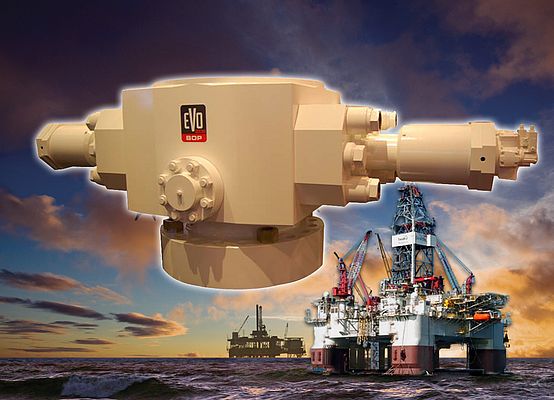Custom built hydraulic motors help Cameron, a major oil and gas flow equipment supplier, to make deep sea oil wells safer, more profitable and productive.
Oil wells are equipped with sophisticated valves called blowout preventers (BOPs) during drilling and completions operation. These devices, positioned at the cap of the well, are designed to shut quickly around the drill pipe or to seal the open wellbore in the event of a well control problem; in essence, they contain pressure in the well, avoiding a potentially catastrophic blowout, thereby protecting lives, capital equipment and preventing the possible release of hydrocarbons into the environment.
Cameron BOPs are installed on half the floating oil production platforms operating worldwide, and on more than 70 percent of the mobile jack-up platforms that can be moved to different locations on the seabed. In 2008, the company’s engineers embarked on a program to develop a new generation of blow out preventers capable of operating at the extraordinary depths and pressures that the industry was beginning to reach.
While existing devices operated at pressures of up to 1034bar, Cameron wanted to make BOPs that could work and contain wellbore pressures of 1378bar in water depths up to 4500m. These extreme pressures and depths presented huge engineering challenges, both in creating a BOP that could shut quickly enough when required, and in ensuring that, once shut, the device could contain the well with no leaks.
High pressure capacity was not the only issue facing the Cameron engineers. Space on the BOP stack of an oil well was already at a premium; the ‘Christmas tree’ structure fitted at the top of the well must contain not only blowout preventers but also a range of other chokes and valves used to control flows into and out of the well. Blowout preventers need to be as compact as possible, so that they don’t take up too much room and to ease installation. They also need to operate reliably for many years in deep see conditions, and routine maintenance must be as straightforward as possible so it can be conducted without disrupting oilfield operations.
During initial prototype conceptual testing the new Cameron BOP hydraulic locking mechanism, initially powered by an off the shelf Parker vane type motor, was not optimised for the application. With time running out before the prototype was due to be qualification tested, Cameron’s engineering team in Houston, Texas explained their issue to Joe Kovach, vice president of Technology at Parker Hannifin. Realising they would be able to help, Kovach sent a text message during the meeting to his technology development manager Lori Martinelli, who was based 2400km away in Cleveland Ohio. Two days later, a team of Parker engineers arrived at Cameron’s HQ to discuss the problem.
Once they understood Cameron’s requirements, the team set to work designing a motor for the new hydraulic actuator that could meet the demanding specifications. The designers used the extensive experience of extreme conditions hydraulic equipment to create a design that used a 250 cc displacement motor designed to operate a hydraulic motor powered locking mechanism able to operate and contain wellbore pressures of up to 1378bar.
The unit, which was more compact than Cameron’s existing design, also included an array of safety and backup features. It could, for example, be actuated by a remotely operated vehicle (ROV) in the event of a total hydraulic failure at the wellhead, a first for this application in the Oil and Gas industry. Three weeks after their initial meeting, the team returned to Cameron to discuss their idea, and five days later the oil equipment firm signed an order for a prototype.
The prototype unit was manufactured at the Calzoni Facility in Bologna, Italy and sent the first unit for testing at Cameron in the middle of September. Cameron put the prototype through an exhaustive validation process over the next two months, and signed off the design for production at the beginning of January 2009. By the end of March, the new actuators were arriving at Cameron’s manufacturing facility for installation on the first of its new generation of BOPs.
To date, over 100 motors have been manufactured and shipped to Cameron, they are already being installed on BOP stacks for operation on wells throughout the world. “Our work with Cameron is a great example of the way Parker uses speed, innovation and dedication to customer service,” concludes Joe Kovach, the man whose single text message set the whole process in motion.
Edited by: Constanze Schmitz
Custom built hydraulic motors
help to reach new depths
- by Parker Hannifin Ltd
- November 17, 2010
- 7278 views

















